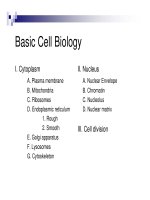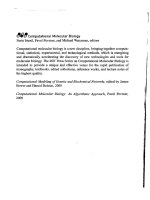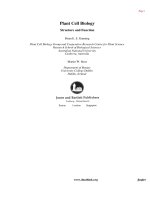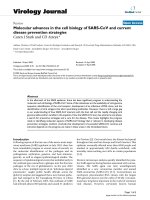computational cell biology - christopher fall, eric marland, john wagner, john tyson
Bạn đang xem bản rút gọn của tài liệu. Xem và tải ngay bản đầy đủ của tài liệu tại đây (9.78 MB, 489 trang )
Computational Cell
Biology
Christopher P. Fall
SPRINGER
Interdisciplinary Applied Mathematics
Volume 20
Editors
S.S. Antman J.E. Marsden
L. Sirovich S. Wiggins
Mathematical Biology
L. Glass, J.D. Murray
Mechanics and Materials
R.V. Kohn
Systems and Control
S.S. Sastry, P.S. Krishnaprasad
Problems in engineering, computational science, and the physical and biological sciences are
using increasingly sophisticated mathematical techniques. Thus, the bridge between the mathemat-
ical sciences and other disciplines is heavily traveled. The correspondingly increased dialog be-
tween the disciplines has led to the establishment of the series: Interdisciplinary Applied Mathe-
matics.
The purpose of this series is to meet the current and future needs for the interaction between
various science and technology areas on the one hand and mathematics on the other. This is done,
firstly, by encouraging the ways that mathematics may be applied in traditional areas, as well as
point towards new and innovative areas of applications; and, secondly, by encouraging other
scientific disciplines to engage in a dialog with mathematicians outlining their problems to both
access new methods and suggest innovative developments within mathematics itself.
The series will consist of monographs and high-level texts from researchers working on the inter-
play between mathematics and other fields of science and technology.
Interdisciplinary Applied Mathematics
Volumes published are listed at the end of this book.
Christopher P. Fall Eric S. Marland John M. Wagner
John J. Tyson
Editors
Computational Cell Biology
With 210 Illustrations
Christopher P. Fall Eric S. Marland John M. Wagner
Center for Neural Science Department of Mathematical Sciences Center for Biomedical Imaging
New York University Appalachian State University Technology
New York, NY 10003 Boone, NC 28608 University of Connecticut Health
USA USA Center
Farmington, CT 06030
USA
John J. Tyson
Department of Biology
Virginia Polytechnic Institute
Blacksburg, VA 24061
USA
Editors
S.S. Antman J.E. Marsden
Department of Mathematics Control and Dynamical Systems
and Mail Code 107-81
Institute for Physical Science and Technology California Institute of Technology
University of Maryland Pasadena, CA 91125
College Park, MD 20742 USA
USA
L. Sirovich S. Wiggins
Division of Control and Dynamical Systems
Applied Mathematics Mail Code 107-81
Brown University California Institute of Technology
Providence, RI 02912 Pasadena, CA 91125
USA USA
Mathematics Subject Classification (2000): 92-01, 92BXX, 92C30, 92C20
Library of Congress Cataloging-in-Publication Data
Computational cell biology / editors, Christopher P. Fall [etal.].
p. cm. — (Interdisciplinary applied mathematics)
Includes bibliographical references and index.
ISBN 0-387-95369-8 (alk. paper)
1. Cytology—Computer simulation. 2. Cytology—Mathematical models. I. Fall, Christopher P.
II. Series.
QH585.5.D38 C65 2002
571.6′01′13—dc21 2001054912
ISBN 0-387-95369-8 Printed on acid-free paper.
2002 Springer-Verlag New York, Inc.
All rights reserved. This work may not be translated or copied in whole or in part without the written permission of the
publisher (Springer-Verlag New York, Inc., 175 Fifth Avenue, New York, NY 10010, USA), except for brief excerpts in
connection with reviews or scholarly analysis. Use in connection with any form of information storage and retrieval,
electronic adaptation, computer software, or by similar or dissimilar methodology now known or hereafter developed is
forbidden.
The use in this publication of trade names, trademarks, service marks and similar terms, even if they are not identified as
such, is not to be taken as an expression of opinion as to whether or not they are subject to proprietary rights.
Printed in the United States of America.
987654321 SPIN 10853277
www.springer-ny.com
Springer-Verlag New York Berlin Heidelberg
A member of BertelsmannSpringer Science+Business Media GmbH
Preface ix
Software: We designed the text to be independent of any particular software, but have
included appendices in support of the XPPAUT package. XPPAUT has been developed
by Bard Ermentrout at the University of Pittsburgh, and it is currently available free
of charge. XPPAUT numerically solves and plots the solutions of ordinary differential
equations. It also incorporates a numerical bifurcation software and some methods for
stochastic equations. Versions are currently available for Windows, Linux, and Unix
systems. Recent changes in the Macintosh platform (OSX) make it possible to use XPP
there as well. Ermentrout has recently published an excellent user’s manual available
through SIAM (Ermentrout 2002).
There are a large number of other software packages available that can accomplish
many of the same things as XPPAUT can, such as MATLAB, MapleV, Mathematica, and
Berkeley Madonna. Programming in C or Fortran is also possible. However XPPAUT
is easy to use, requires minimal programming skills, has an excellent online tutorial,
and is distributed without charge. The aspect of XPPAUT which is available in very
few other places is the bifurcation software AUTO, originally developed by E.J. Doedel.
The bifurcation tools in XPPAUT are necessary only for selected problems, so many
of the other packages will suffice for most of the book. The the book and web site
contain code that will reproduce many of the figures in the book. As students solve the
exercises and replicate the simulations using other packages, we would encourage the
submission of the code to the editors. We will incorporate this code into the web site
and possibly into future editions of the book.
There are many people to thank for their help with this project. Of course, we
are deeply indebted to the contributors, who first completed or wrote from scratch the
chapters and then dealt with the numerous revisions necessary to homogenize the book
to a reasonable level. Carla Wofsy and Byron Goldstein, as well as Albert Goldbeter,
encouraged us to go forward with the project and provided valuable suggestions. We
thank Chris Dugaw and David Quinonez for their assistance with typesetting several
of the chapters, and Randy Szeto for his work with the graphic design of the book. We
thank James Sneyd for many helpful comments on the manuscript, and also Tim Lewis
for commenting on several of the chapters. Carol Lucas generously provided many
corrections for the first half of the text. C.F., J.W., and E.M. were supported in part by
the Institute of Theoretical Dynamics at UC Davis during some of the preparation of
the manuscript.
We suspect that Joel, for a start, would have thanked Lee Segel, Jim Murray,
Leah Edelstein-Keshet and others whose pioneering textbooks in mathematical biol-
ogy certainly informed this one. We know that Joel would have thanked many friends
and colleagues for contributing to the true excitement he felt in his “second career”
studying biology. While we have dedicated this work to the memory of Joel, Joel’s
dedication might well have been to his wife, Susan; his daughter, Sarah; his son and
daughter-in-law, Sidney and Noelle; and his grandson, Justin Joel.
We hope you enjoy this text, and we look forward to your comments and sugges-
tions. We strongly believe that a textbook such as this might serve to help to develop the
field of computational cell biology by introducing students to the subject. This textbook
Joel Edward Keizer 1942–1999
Joel Keizer’s thirty years of scientific work set a standard for collaborative research in
theoretical chemistry and biology. Joel served the University of California at Davis for 28
years, as a Professor in the Departments of Chemistry and of Neurobiology, Physiology
and Behavior, and as founder and Director of the Institute for Theoretical Dynamics.
Working at the boundary between experiment and theory, Joel built networks of collab-
orations and friendships that continue to grow and produce results. This book evolved
from a textbook that Joel began but was not able to finish. The general outline and
goals of the book were laid out by Joel, on the basis of his many years of teaching and
research in computational cell biology. Those of us who helped to finish the project—as
authors and editors—are happy to dedicate our labors to the memory of our friend and
colleague, Joel Edward Keizer. All royalties from this book are to be directed to the
Joel E. Keizer Memorial Fund for collaborative interdisciplinary research in the life
sciences.
This page intentionally left blank
Preface
This text is an introduction to dynamical modeling in cell biology. It is not meant
as a complete overview of modeling or of particular models in cell biology. Rather,
we use selected biological examples to motivate the concepts and techniques used in
computational cell biology. This is done through a progression of increasingly more
complex cellular functions modeled with increasingly complex mathematical and com-
putational techniques. There are other excellent sources for material on mathematical
cell biology, and so the focus here truly is computer modeling. This does not mean that
there are no mathematical techniques introduced, because some of them are absolutely
vital, but it does mean that much of the mathematics is explained in a more intuitive
fashion, while we allow the computer to do most of the work.
The target audience for this text is mathematically sophisticated cell biology or
neuroscience students or mathematics students who wish to learn about modeling in
cell biology. The ideal class would comprise both biology and applied math students,
who might be encouraged to collaborate on exercises or class projects. We assume
as little mathematical and biological background as we feel we can get away with,
and we proceed fairly slowly. The techniques and approaches covered in the first half
of the book will form a basis for some elementary modeling or as a lead in to more
advanced topics covered in the second half of the book. Our goal for this text is to
encourage mathematics students to consider collaboration with experimentalists and
to provide students in cell biology and neuroscience with the tools necessary to access
the modeling literature and appreciate the value of theoretical approaches.
The core of this book is a set of notes for a textbook written by Joel Keizer before his
death in 1999. In addition to many other accomplishments as a scientist, Joel founded
and directed the Institute of Theoretical Dynamics at the University of California, Davis.
It is currently the home of a training program for young scientists studying nonlinear
viii Preface
dynamics in biology. As a part of this training program Joel taught a course entitled
“Computational Models of Cellular Signaling,” which covered much of the material in
the first half of this book.
Joel took palpable joy from interaction with his colleagues, and in addition to his
truly notable accomplishments as a theorist in both chemistry and biology, perhaps his
greatest skill was his ability to bring diverse people together in successful collaboration.
It is in recognition of this gift that Joel’s friends and colleagues have brought this text to
completion. We have expanded the scope, but at the core, you will still find Joel’s hand in
the approach, methodology, and commitment to the interdisciplinary and collaborative
nature of the field. The royalties from the book will be donated to the Joel E. Keizer
foundation at the University of California at Davis, which promotes interdisciplinary
collaboration between mathematics, the physical sciences, and biology.
Audience: We have aimed this text at an advanced undergraduate or beginning graduate
audience in either mathematics or biology.
Prerequisites: We assume that students have taken full–year courses in calculus and
biology. Introductory courses in differential equations and molecular cell biology are
desirable but not absolutely necessary. Students with more substantial background in
either biology or mathematics will benefit all the more from this text, especially the
second half. No former programming experience is needed, but a working knowledge of
using computers will make the learning curve much more pleasant. Note that we often
point students to other textbooks and monographs, both because they are important
references for later use and because they might be a better source for the material.
Instructors may want to have these sources available for students to borrow or consult.
Organization: We consider the first six chapters, through intercellular communication,
to be the core of the text. They cover the basic elements of compartmental modeling,
and they should be accessible to anyone with a minimum background in cell biology
and calculus. The remainder of the chapters cover more specialized topics that can be
selected from, based on the focus of the course. Chapters 7 and 8 introduce spatial
modeling, Chapters 9 and 10 discuss biochemical oscillations and the cell cycle, and
Chapters 11–13 cover stochastic methods and models. These chapters are of varying
degrees of difficulty.
Finally, in the first appendix, some of the mathematical and computational con-
cepts brought up throughout the book are covered in more detail. This appendix is
meant to be a reference and a learning tool. Sections of it may be integrated into the
chapters as the topics are introduced. The second appendix contains an introduction to
the XPPAUT ODE package discussed below. The final appendix contains psuedocode
versions of the code used to create some of the data figures in the text.
Internet Resources: This book will have its own web page which will contain a va-
riety of resources. We will maintain a list of the inevitable mistakes and typos and
will make available actual code for the figures in the book. The web address is
.
x Preface
will be more successful in helping to forge a community if it represents what most of
us agree is necessary to teach beginning students. This is only a first step, and we truly
look forward both to input about the material already presented and to suggestions
and contributions of additional material and topics for future editions.
Contributors
Timothy C. Elston
North Carolina State University
Department of Statistics
G. Bard Ermentrout
University of Pittsburgh
Department of Mathematics
Christopher P. Fall
New York University
Center for Neural Science
James P. Keener
University of Utah
Department of Mathematics
Joel E. Keizer
University of California at Davis
Institute of Theoretical Dynamics
Yue-Xian Li
University of British Columbia
Department of Mathematics
Eric S. Marland
Appalachian State University
Department of Mathematical Sciences
Alexander Mogilner
University of California at Davis
Department of Mathematics
B
´
ela Nov
´
ak
Budapest University of Technology and
Economics
Department of Agricultural Chemical
Technology
George Oster
University of California at Berkeley
Departments of Molecular and Cellular Biology
and ESPM
John E. Pearson
Los Alamos National Laboratory
Applied Theoretical and Computational Physics
John Rinzel
New York University
Center for Neural Science and
Courant Institute of Mathematical Sciences
Arthur S. Sherman
National Institutes of Health
Mathematical Research Branch
National Institute of Diabetes and
Digestive and Kidney Diseases
Gregory D. Smith
College of William and Mary
Department of Applied Science
John J. Tyson
Virginia Polytechnic Institute
and State University
Department of Biology
John M. Wagner
University of Connecticut Health Center
Center for Biomedical Imaging Technology
Hongyun Wang
University of California at Santa Cruz
Department of Applied Mathematics
and Statistics
Graphic design by
Randy Szeto
This page intentionally left blank
Contents
Preface vii
I Introductory Course 1
1 Dynamic Phenomena in Cells 3
1.1 Scope of Cellular Dynamics . 3
1.2 Computational Modeling in Biology . 8
1.2.1 Cartoons, Mechanisms, and Models . 8
1.2.2 The Role of Computation . 9
1.2.3 The Role of Mathematics . 10
1.3 A Simple Molecular Switch . 11
1.4 Solving and Analyzing Differential Equations . 13
1.4.1 Numerical Integration of Differential Equations . 15
1.4.2 Introduction to Numerical Packages . 18
1.5 Exercises . 20
2 Voltage Gated Ionic Currents 21
2.1 Basis of the Ionic Battery . 23
2.1.1 The Nernst Potential: Charge Balances Concentration . 24
2.1.2 The Resting Membrane Potential . 26
2.2 The Membrane Model . 27
2.2.1 Equations for Membrane Electrical Behavior . 28
2.3 Activation and Inactivation Gates . 29
2.3.1 Models of Voltage–Dependent Gating . 29
xiv Contents
2.3.2 TheVoltageClamp . 31
2.4 Interacting Ion Channels: The Morris–Lecar Model . 34
2.4.1 Phase Plane Analysis . 36
2.4.2 Stability Analysis . 38
2.4.3 Why Do Oscillations Occur? . 40
2.4.4 Excitability and Action Potentials . 43
2.4.5 TypeIandTypeIISpiking . 44
2.5 The Hodgkin–Huxley Model . 45
2.6 FitzHugh–Nagumo Class Models . 47
2.7 Summary . 49
2.8 Exercises . 50
3 Transporters and Pumps 53
3.1 Passive Transport . 54
3.2 Transporter Rates . 57
3.2.1 Algebraic Method . 59
3.2.2 Diagrammatic Method . 60
3.2.3 Rate of the GLUT Transporter . 62
3.3 The Na
+
/Glucose Cotransporter . 65
3.4 SERCA Pumps . 70
3.5 Transport Cycles . 73
3.6 Exercises . 76
4 Fast and Slow Time Scales 77
4.1 The Rapid Equilibrium Approximation . 78
4.2 Asymptotic Analysis of Time Scales . 82
4.3 Glucose–Dependent Insulin Secretion . 83
4.4 Ligand Gated Channels . 88
4.5 The Neuromuscular Junction . 90
4.6 The Inositol Trisphosphate (IP
3
) receptor . 91
4.7 Michaelis–Menten Kinetics . 94
4.8 Exercises . 98
5 Whole–Cell Models 101
5.1 Models of ER and PM Calcium Handling . 102
5.1.1 Flux Balance Equations with Rapid Buffering . 103
5.1.2 Expressions for the Fluxes . 106
5.2 Calcium Oscillations in the Bullfrog Sympathetic Ganglion Neuron . 107
5.2.1 Ryanodine Receptor Kinetics: The Keizer–Levine Model . . . . 108
5.2.2 Bullfrog Sympathetic Ganglion Neuron Closed–Cell Model . . 111
5.2.3 Bullfrog Sympathetic Ganglion Neuron Open–Cell Model . . . 113
5.3 The Pituitary Gonadotroph . 115
5.3.1 The ER Oscillator in a Closed Cell . 116
Contents xix
A.2 A Brief Review of Power Series . 380
A.3 Linear ODEs . 382
A.3.1 Solution of Systems of Linear ODEs . 383
A.3.2 Numerical Solutions of ODEs . 385
A.3.3 Eigenvalues and Eigenvectors . 386
A.4 Phase Plane Analysis . 388
A.4.1 Stability of Linear Steady States . 390
A.4.2 Stability of a Nonlinear Steady States . 392
A.5 Bifurcation Theory . 395
A.5.1 Bifurcation at a Zero Eigenvalue . 396
A.5.2 Bifurcation at a Pair of Imaginary Eigenvalues . 398
A.6 Perturbation Theory . 401
A.6.1 Regular Perturbation . 401
A.6.2 Resonances . 403
A.6.3 Singular Perturbation Theory . 405
A.7 Exercises . 408
B Solving and Analyzing Dynamical Systems Using XPPAUT 410
B.1 Basics of Solving Ordinary Differential Equations . 411
B.1.1 Creating the ODE File . 411
B.1.2 Running the Program . 412
B.1.3 The Main Window . 413
B.1.4 Solving the Equations, Graphing, and Plotting. . 414
B.1.5 Saving and Printing Plots . 416
B.1.6 Changing Parameters and Initial Data . 418
B.1.7 Looking at the Numbers: The Data Viewer . 419
B.1.8 Saving and Restoring the State of Simulations . 420
B.1.9 Important Numerical Parameters . 421
B.1.10 Command Summary: The Basics . 422
B.2 Phase Planes and Nonlinear Equations . 422
B.2.1 DirectionFields . 423
B.2.2 NullclinesandFixedPoints . 423
B.2.3 Command Summary: Phase Planes and Fixed Points . 426
B.3 Bifurcation and Continuation . 427
B.3.1 General Steps for Bifurcation Analysis . 427
B.3.2 Hopf Bifurcation in the FitzHugh–Nagumo Equations . 428
B.3.3 Hints for Computing Complete Bifurcation Diagrams . 430
B.4 Partial Differential Equations: The Method of Lines . 432
B.5 Stochastic Equations . 434
B.5.1 A Simple Brownian Ratchet . 434
B.5.2 A Sodium Channel Model . 434
B.5.3 A Flashing Ratchet . 436
Contents xv
5.3.2 Open–Cell Model with Constant Calcium Influx . 122
5.3.3 The Plasma Membrane Oscillator . 124
5.3.4 Bursting Driven by the ER in the Full Model . 126
5.4 The Pancreatic Beta Cell . 128
5.4.1 Chay–Keizer Model . 129
5.4.2 Chay–Keizer with an ER . 133
5.5 Exercises . 136
6 Intercellular Communication 140
6.1 Electrical Coupling and Gap Junctions . 141
6.1.1 Synchronization of Two Oscillators . 142
6.1.2 Asynchrony Between Oscillators . 143
6.1.3 Cell Ensembles, Electrical Coupling Length Scale . 144
6.2 Synaptic Transmission Between Neurons . 146
6.2.1 Kinetics of Postsynaptic Current . 147
6.2.2 Synapses: Excitatory and Inhibitory; Fast and Slow . 148
6.3 When Synapses Might (or Might Not) Synchronize Active Cells . . . . 150
6.4 Neural Circuits as Computational Devices . 153
6.5 Large–Scale Networks . 159
6.6 Exercises . 165
II Advanced Material 169
7 Spatial Modeling 171
7.1 One-Dimensional Formulation . 173
7.1.1 Conservation in One Dimension . 173
7.1.2 Fick’sLawofDiffusion . 175
7.1.3 Advection . 176
7.1.4 Flux of Ions in a Field . 177
7.1.5 The Cable Equation . 177
7.1.6 Boundary and Initial Conditions . 178
7.2 Important Examples with Analytic Solutions . 179
7.2.1 Diffusion Through a Membrane . 179
7.2.2 Ion Flux Through a Channel . 180
7.2.3 Voltage Clamping . 181
7.2.4 Diffusion in a Long Dendrite . 181
7.2.5 DiffusionintoaCapillary . 183
7.3 Numerical Solution of the Diffusion Equation . 184
7.4 Multidimensional Problems . 186
7.4.1 Conservation Law in Multiple Dimensions . 186
7.4.2 Fick’s Law in Multiple Dimensions . 187
7.4.3 Advection in Multiple Dimensions . 188
xvi Contents
7.4.4 Boundary and Initial Conditions for Multiple Dimensions . . . 188
7.4.5 Diffusion in Multiple Dimensions: Symmetry . 188
7.5 Traveling Waves in Nonlinear Reaction–Diffusion Equations . 189
7.5.1 Traveling Wave Solutions . 190
7.5.2 Traveling Wave in the Fitzhugh–Nagumo Equations . 192
7.6 Exercises . 195
8 Modeling Intracellular Calcium Waves and Sparks 198
8.1 Microfluorometric Measurements . 198
8.2 A Model of the Fertilization Calcium Wave . 200
8.3 Including Calcium Buffers in Spatial Models . 202
8.4 The Effective Diffusion Coefficient . 203
8.5 Simulation of a Fertilization Calcium Wave . 204
8.6 Simulation of a Traveling Front . 204
8.7 Calcium Waves in the Immature Xenopus Oocycte . 208
8.8 Simulation of a Traveling Pulse . 208
8.9 Simulation of a Kinematic Wave . 210
8.10 Spark-Mediated Calcium Waves . 213
8.11 The Fire–Diffuse–Fire Model . 214
8.12 Modeling Localized Calcium Elevations . 220
8.13 Steady-State Localized Calcium Elevations . 222
8.13.1 The Steady–State Excess Buffer Approximation (EBA) . 224
8.13.2 The Steady–State Rapid Buffer Approximation (RBA) . 225
8.13.3 Complementarity of the Steady-State EBA and RBA . 226
8.14 Exercises . 227
9 Biochemical Oscillations 230
9.1 Biochemical Kinetics and Feedback . 232
9.2 Regulatory Enzymes . 236
9.3 Two-Component Oscillators Based on Autocatalysis . 239
9.3.1 Substrate–Depletion Oscillator . 240
9.3.2 Activator–Inhibitor Oscillator . 242
9.4 Three-Component Networks Without Autocatalysis . 243
9.4.1 Positive Feedback Loop and the Routh–Hurwitz Theorem . . . 244
9.4.2 Negative Feedback Oscillations . 244
9.4.3 The Goodwin Oscillator . 244
9.5 Time-Delayed Negative Feedback . 247
9.5.1 Distributed Time Lag and the Linear Chain Trick . 248
9.5.2 Discrete Time Lag . 249
9.6 Circadian Rhythms . 250
9.7 Exercises . 255
Contents xvii
10 Cell Cycle Controls 261
10.1 Physiology of the Cell Cycle in Eukaryotes . 261
10.2 Molecular Mechanisms of Cell Cycle Control . 263
10.3 A Toy Model of Start and Finish . 265
10.3.1 Hysteresis in the Interactions Between Cdk and APC . 266
10.3.2 Activation of the APC at Anaphase . 267
10.4 A Serious Model of the Budding Yeast Cell Cycle . 269
10.5 Cell Cycle Controls in Fission Yeast . 273
10.6 Checkpoints and Surveillance Mechanisms . 276
10.7 Division Controls in Egg Cells . 276
10.8 Growth and Division Controls in Metazoans . 278
10.9 Spontaneous Limit Cycle or Hysteresis Loop? . 279
10.10 Exercises . 281
11 Modeling the Stochastic Gating of Ion Channels 285
11.1 Single–Channel Gating and a Two-State Model . 285
11.1.1 Modeling Channel Gating as a Markov Process . 286
11.1.2 The Transition Probability Matrix . 288
11.1.3 Dwell Times . 289
11.1.4 Monte Carlo Simulation . 290
11.1.5 Simulating Multiple Independent Channels . 291
11.1.6 Gillespie’s Method . 292
11.2 An Ensemble of Two-State Ion Channels . 293
11.2.1 Probability of Finding N Channels in the Open State . 293
11.2.2 The Average Number of Open Channels . 296
11.2.3 The Variance of the Number of Open Channels . 297
11.3 Fluctuations in Macroscopic Currents . 298
11.4 Modeling Fluctuations in Macroscopic Currents with Stochastic
ODEs . 302
11.4.1 Langevin Equation for an Ensemble of Two-State Channels . . 304
11.4.2 Fokker–Planck Equation for an Ensemble of Two-State
Channels . 306
11.5 Membrane Voltage Fluctuations . 307
11.5.1 Membrane Voltage Fluctuations with an Ensemble of
Two-State Channels . 309
11.6 Stochasticity and Discreteness in an Excitable Membrane Model . . . 311
11.6.1 Phenomena Induced by Stochasticity and Discreteness . 312
11.6.2 The Ensemble Density Approach Applied to the Stochastic
Morris–Lecar Model . 313
11.6.3 Langevin Formulation for the Stochastic Morris–Lecar Model . 314
11.7 Exercises . 317
xviii Contents
12 Molecular Motors: Theory 320
12.1 Molecular Motions as Stochastic Processes . 323
12.1.1 Protein Motion as a Simple Random Walk . 323
12.1.2 Polymer Growth . 325
12.1.3 Sample Paths of Polymer Growth . 327
12.1.4 The Statistical Behavior of Polymer Growth . 329
12.2 Modeling Molecular Motions . 330
12.2.1 The Langevin Equation . 330
12.2.2 Numerical Simulation of the Langevin Equation . 332
12.2.3 The Smoluchowski Model . 333
12.2.4 First Passage Time . 334
12.3 Modeling Chemical Reactions . 335
12.4 A Mechanochemical Model . 338
12.5 Numerical Simulation of Protein Motion . 339
12.5.1 Numerical Algorithm that Preserves Detailed Balance . 340
12.5.2 Boundary Conditions . 341
12.5.3 Numerical Stability . 342
12.5.4 Implicit Discretization . 344
12.6 Derivations and Comments . 345
12.6.1 The Drag Coefficient . 345
12.6.2 The Equipartition Theorem . 345
12.6.3 A Numerical Method for the Langevin Equation . 346
12.6.4 Some Connections with Thermodynamics . 347
12.6.5 Jumping Beans and Entropy . 349
12.6.6 Jump Rates . 350
12.6.7 Jump Rates at an Absorbing Boundary . 351
12.7 Exercises . 353
13 Molecular Motors: Examples 354
13.1 Switching in the Bacterial Flagellar Motor . 354
13.2 A Motor Driven by a “Flashing Potential” . 359
13.3 The Polymerization Ratchet . 362
13.4 Simplified Model of the F
0
Motor . 364
13.4.1 The Average Velocity of the Motor in the Limit of Fast
Diffusion . 366
13.4.2 Brownian Ratchet vs. Power Stroke . 369
13.4.3 The Average Velocity of the Motor When Chemical Reactions
Are as Fast as Diffusion . 369
13.5 Other Motor Proteins . 374
13.6 Exercises . 376
A Qualitative Analysis of Differential Equations 378
A.1 Matrix and Vector Manipulation . 379
xx Contents
C Numerical Algorithms 439
References 451
Index 463
PART I
Introductory Course
This page intentionally left blank
CHAPTER 1
Dynamic Phenomena in Cells
Christopher P. Fall and Joel E. Keizer
Over the past several decades, progress in the measurement of rates and interactions of
molecular and cellular processes has initiated a revolution in our understanding of dy-
namic phenomena in cells. Spikes or bursts of plasma membrane electrical activity or
intracellular signaling via receptors, second messengers, or other networked biochem-
ical pathways in single cells, or more complex processes that involve small clusters of
cells, organelles, or groups of neurons, are examples of the complex behaviors that we
know take place on the cellular scale. The vast amount of quantitative information un-
covered in recent years, leveraged by the intricate mechanisms already shown to exist,
results in an array of possibilities that makes it quite hard to evaluate new hypothe-
ses on an intuitive basis. Using mathematical analysis and computer simulation we
can show that some seemingly reasonable hypotheses are not possible. Analysis and
simulations that confirm that a given hypothesis is reasonable can often result in quan-
titative predictions for further experimental exploration. Rapid advances in computer
hardware and software technology combined with pioneering work giving structure to
the interface between mathematics and biology have put the ability to test hypotheses
and evaluate mechanisms with simulations within the reach of all cell biologists and
neuroscientists.
1.1 Scope of Cellular Dynamics
Generally speaking, the phrase dynamic phenomenon refers to any process or observ-
able that changes over time. Living cells are inherently dynamic. Indeed, to sustain
4 1: Dynamic Phenomena in Cells
E
a
ab
Stimulus
E
b
A
B
Figure 1.1 (A) Schematic diagram of the recording electrodes (a and b) used to detect action
potentials following a stimulus shock in an isolated giant axon from squid. Adapted from Hille
(2001). (B) The membrane potential recorded at electrodes a and b in the upper panel following
a depolarizing shock. Reprinted from delCastillo and Moore (1959).
the characteristic features of life such as growth, cell division, intercellular commu-
nication, movement, and responsiveness to their environment, cells must continually
extract energy from their surroundings. This requires that cells function thermody-
namically as open systems that are far from static thermal equilibrium. Much energy
is utilized by cells in the maintenance of gradients of ions and metabolites necessary
for proper function. These processes are inherently dynamic due to the continuous
movement of ionic and molecular species across the cell membrane.
Electrical activity of excitable cells is a widely studied example of cellular dynamics.
The classical behavior of an action potential in the squid giant axon is shown in Figure
1.1. This single spike of electrical activity, initiated by a small positive current applied
by an external electrode, propagates as a traveling pulse along the axonal membrane.
Hodgkin and Huxley were the first to propose a satisfactory explanation for action
potentials that incorporated experimental measurements of the response of the squid
axon to depolarizations of the membrane potential. We will describe voltage gated ion
channel models in Chapter 2.
Membrane transporters allow cells to take up glucose from the blood plasma. Cells
then use glycolytic enzymes to convert energy from carbon and oxygen bonds to phos-
phorylate adenosine diphosphate (ADP) and produce the triphosphate ATP. ATP, in
turn, is utilized to pump Ca
2+
and Na
+
ions from the cell and K
+
ions back into the
cell, in order to maintain the osmotic balance that helps give red cells the character-
istic shape shown in Figure 1.2. ATP is also used to maintain the concentration of
2,3-diphosphoglycerate, an intermediary metabolite that regulates the oxygen binding
conformation of hemoglobin. The final products of glucose metabolism in red cells are
pyruvate and lactate, which move passively out of the cell down a concentration gradi-
ent through specific transporters in the plasma membrane. Because red cells possess
neither a nucleus nor mitochondria, they are not capable of reproduction or energet-
ically demanding processes. Nonetheless, by continually extracting energy from the
transformation of glucose to lactate, red blood cells maintain the capacity to shuttle
oxygen and carbon dioxide between the lungs and the capillaries. Remarkably, this









